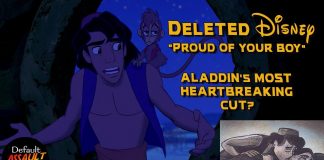Make Mine Music was the first post-World War II Disney release and the first of two musical anthology films that I like to call “Contemporary Fantasias” (the other being Melody Time released two years later). Of all the features in the official Disney animated canon, this is probably the least well known and most contemporary home video releases feature a film far more truncated by modern day censorship than any other Disney film available.
Walt Disney’s Make Mine Music |
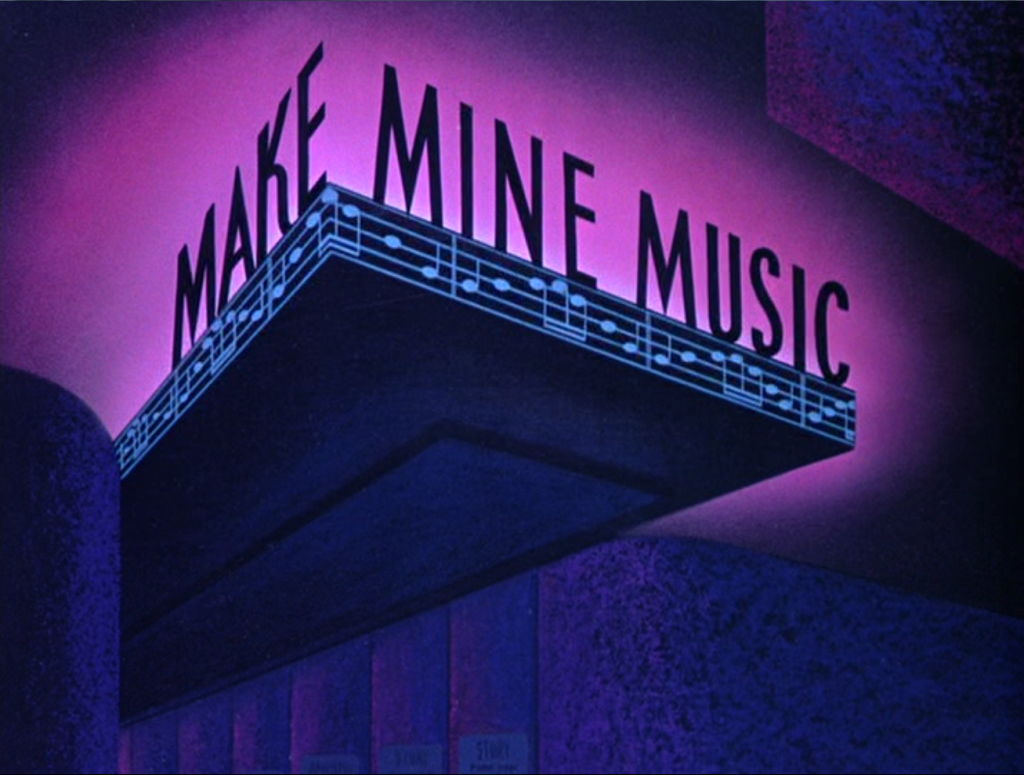 Make Mine Music opens with a light up marquee showcasing all the musical talent involved in the project as the utterly forgettable title song plays on – not a good sign for a movie with “music” in its name. It is here within the first minute of the film where we witness the first evidence of alterations made to the video release:
Make Mine Music opens with a light up marquee showcasing all the musical talent involved in the project as the utterly forgettable title song plays on – not a good sign for a movie with “music” in its name. It is here within the first minute of the film where we witness the first evidence of alterations made to the video release:
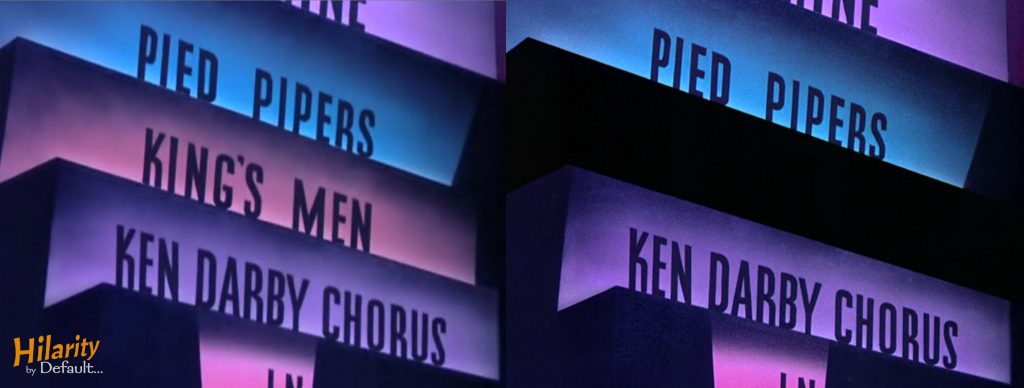
As the credits end, we are ushered into a theater and presented with the program’s playbook (which has also been altered):
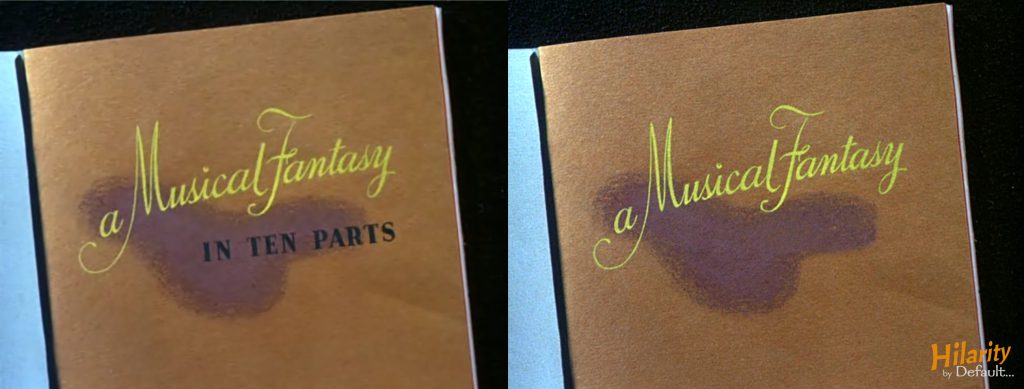
It’s an adequate opening, reminiscent of Fantasia but nowhere near as grand. What follows are nine or ten short cartoons (depending on your copy of the film), each representing a different genre of music.
The Martins and the Coys
|
2.0
|
Don’t recognize “The Martins and the Coys?” It’s because Disney has excised the entire seven-minute segment from its North American DVD release for “graphic gunplay not suitable for children.”
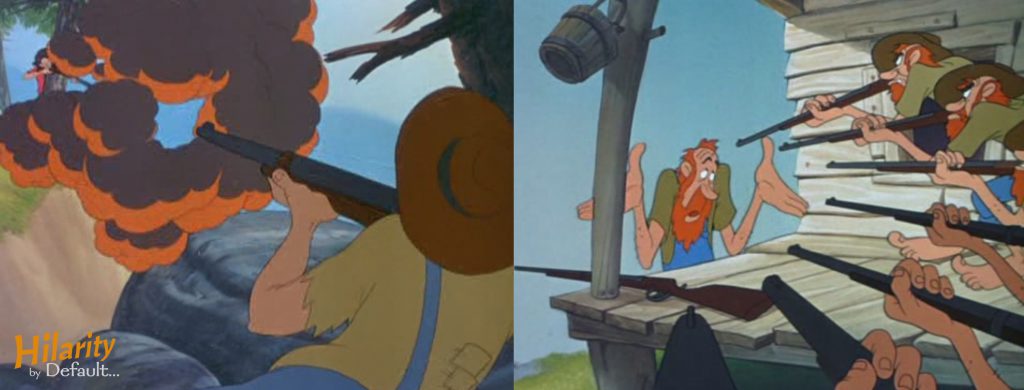
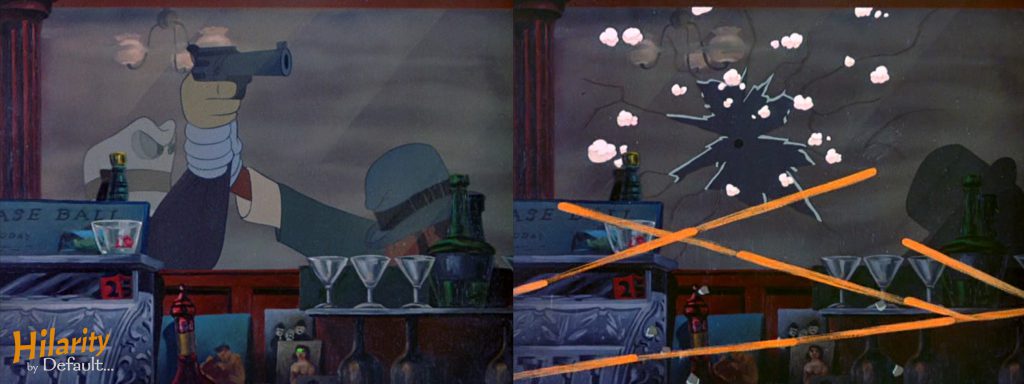
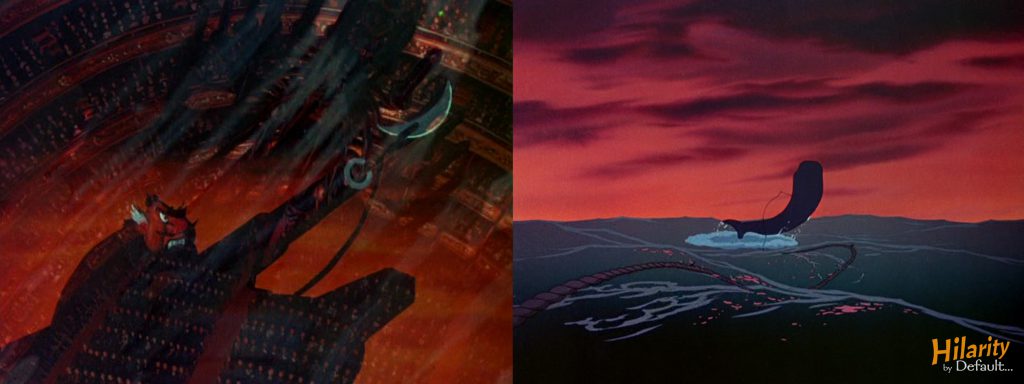
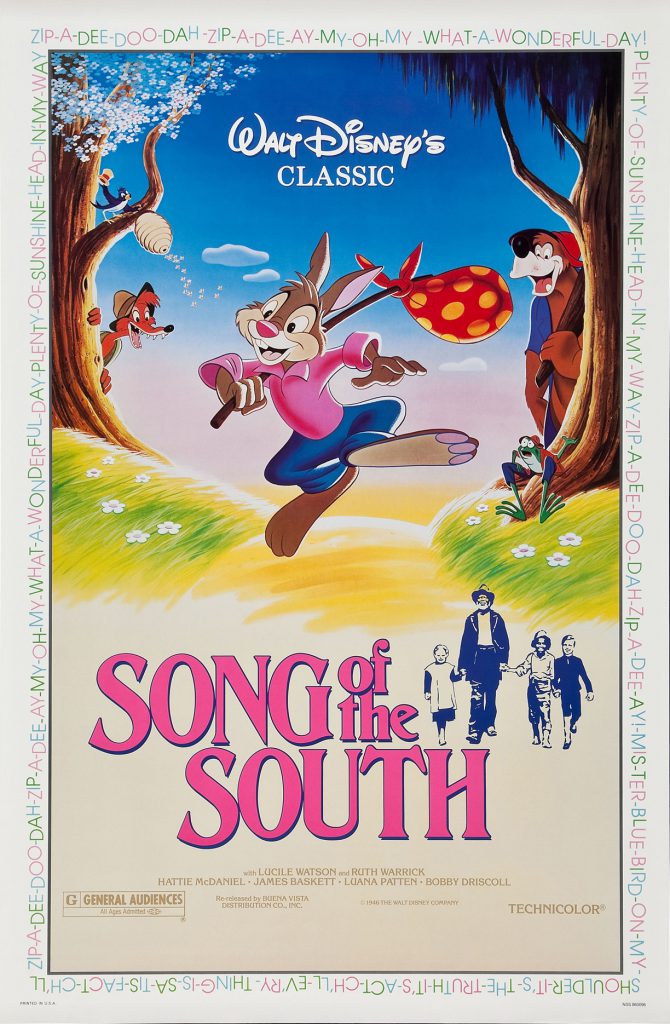
Inspired by the infamous Hatfield and McCoy feud of the late 1800’s…

…”The Martins and the Coys” focuses on two neighboring groups of hillbillies who one day begin a violent battle over the theft of chicken eggs. This leads to them all getting wiped out in the ensuing gun fights save for one kin each – Grace Martin and Henry Coy – who naturally fall in love in true Romeo and Juliet fashion.
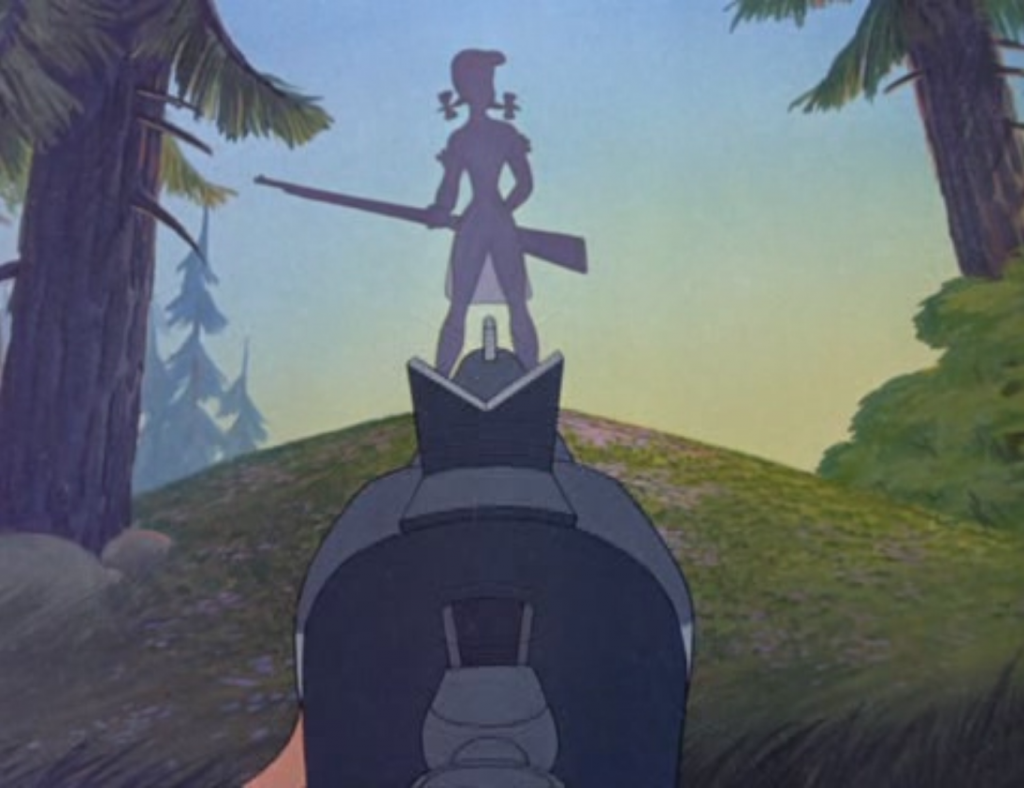
It is an amusing sequence with a lively ballad by the King’s Men and some clever visual puns, but overall it’s rather bland. Apart from some good character designs (the curvaceous Grace and the hulking Henry in particular), the animation quality is erratic ranging between poor and passable which is far more noticeable when it occurs from shot to shot as seen below:
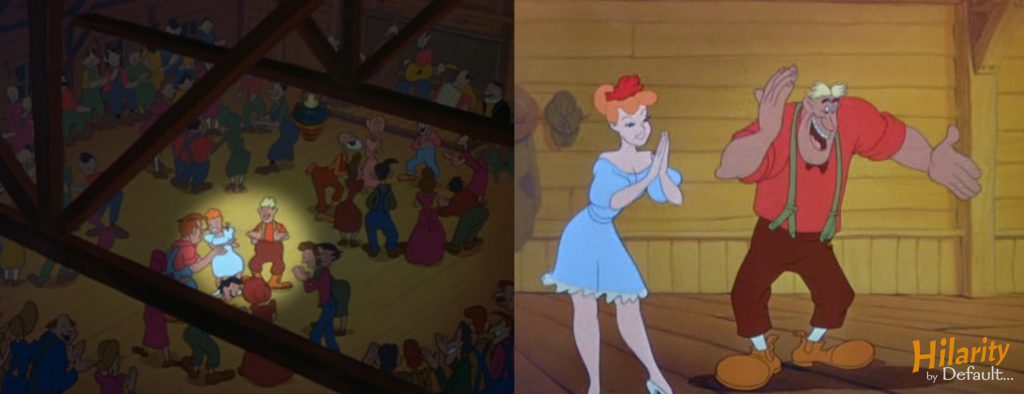
In fact, it could be said that the notoriety afforded to it by its senseless eradication from DVD is more than it deserves; however, it is a decent, upbeat start to the film. This is especially notable due the generally somber and marginally melancholic nature of many of Make Mine Music‘s ten segments. With the exception of “Casey at the Bat,” this is Music‘s only true slapstick piece and its exclusion subsequently hurts the film’s balance.
Blue Bayou
|
2.0
|
With the removal of “The Martins and the Coys,” Make Mine Music suffers from a somewhat anemic beginning with the lethargic “Blue Bayou.” Scored to the anesthetizing title tune sung by the Ken Darby Chorus, the sequence centers around an egret taking flight through the Everglades before, spoiler alert, meeting up with another egret.
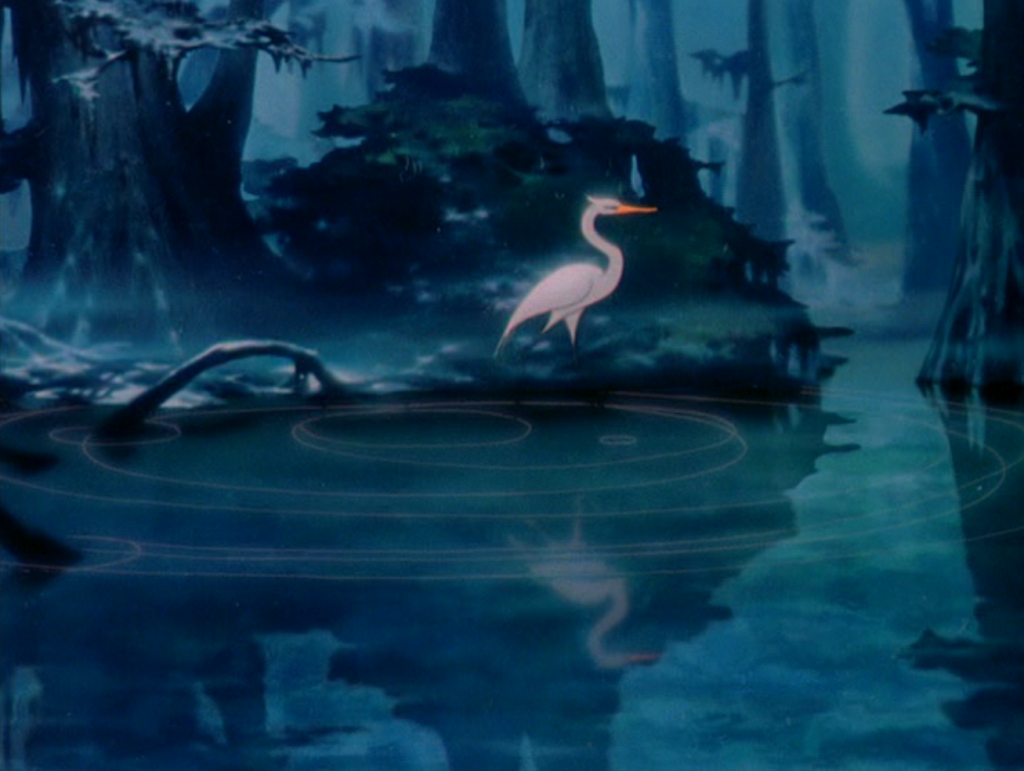
“Blue Bayou” was originally animated and intended to be part of Fantasia, scored to a completely different piece of music – “Clair de Lune” by Claude Debussy. With this consideration in mind, it is not surprising to note that the one aspect of “Blue Bayou” that shines is its extraordinary animation. In fact, it would not be hyperbolic to state that it may be the most beautiful, artistically merited animated segment of all the 1940’s package films which makes it disheartening to admit that it is flat out boring.
Recycled for this movie, Disney ditched the classical Debussy for the “tone poem” “Blue Bayou.” The song barely has anything to do with what’s happening on screen with the exception of its location. True, it can possibly be surmised that the love song is intended to be about the egret and its mate, but these are not anthropomorphic cartoon caricatures to whom these lyrical traits would be applicable. Are we to assume that this egret is truly “still haunted by the ghost of long ago” as the song suggests? Is this an egret with deep psychological trauma? Essentially, the discord between the song and the animation lends the whole sequence a disconnected, languid energy.
Now compare this to its choreography with the intended “Clair de Lune” (available as a bonus feature with most releases of Fantasia) and the sequence instantly springs to life. The flight of the stork is now correspondent to the gentle melody of the piece attributing a soaring spirit to the whole endeavor. Heck, this version was actually longer, playing a bit more with the synchronism of rippling water sparkling to the moon’s reflection. Nevertheless, it’s easy to see why it was cut from the already overlong (at 125 minutes) Fantasia as it would have certainly been the weakest portion of the film, competing with segments with far more creativity and intensity than “Clair de Lune” can muster at any point in its six-minute run-time.
All the Cats Join In
|
4.0
|
While “All the Cats Join In” may not technically be the best episode of Make Mine Music, it is by far my favorite. With a minimalist, caricature-based animated style that was atypical to the sleek products Disney was known for, “All the Cats” is an imaginative, hilarious sequence that provides a large dose of vitality to the film following the practically comatose “Blue Bayou.”
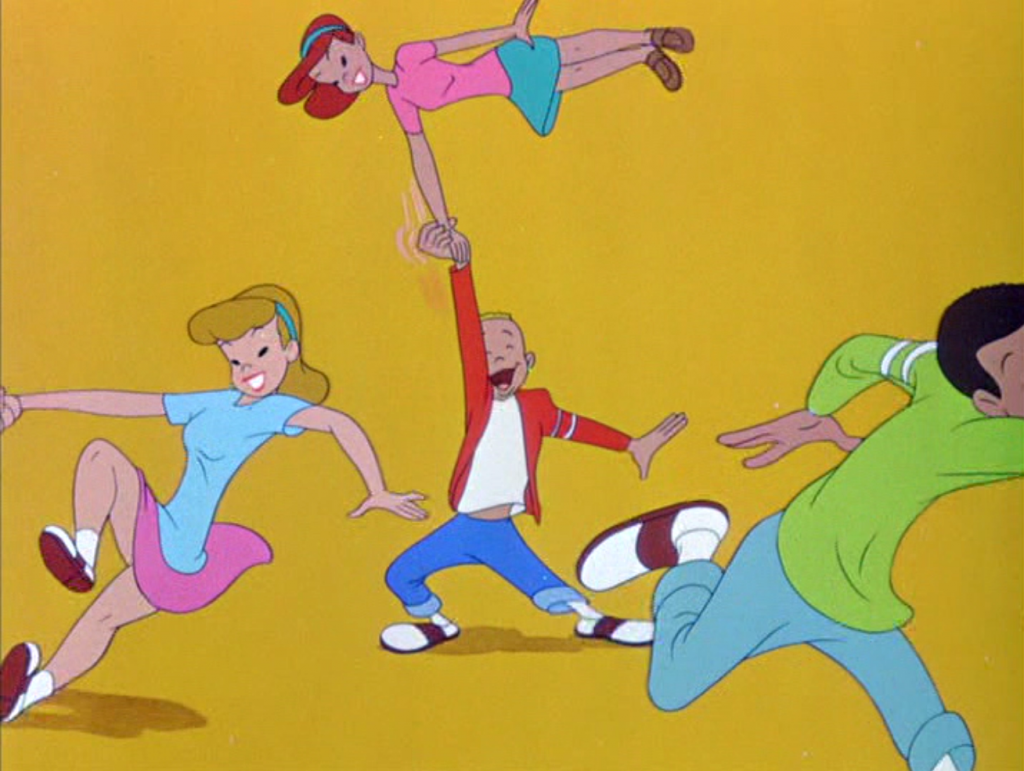 The short opens with a sketch artist animating an impromptu dance at a local malt shop. With artist’s pencil serving as a stylized, recurring motif, “All the Cats” bounds with a brisk energy that can barely keep up with the sketcher’s technique. It’s an effectively simple, fast-paced set-piece that is bolstered by an equally engaging score by Benny Goodman and his Orchestra. The character animation here is superb, particularly the girls who were drawn by the gifted Fred Moore who specialized in crafting shapely, virtuous figures that have come to be known as the “Freddie Moore Girls” (he was also responsible for the centaurettes from Fantasia and the mermaids from Peter Pan, to name a few).
The short opens with a sketch artist animating an impromptu dance at a local malt shop. With artist’s pencil serving as a stylized, recurring motif, “All the Cats” bounds with a brisk energy that can barely keep up with the sketcher’s technique. It’s an effectively simple, fast-paced set-piece that is bolstered by an equally engaging score by Benny Goodman and his Orchestra. The character animation here is superb, particularly the girls who were drawn by the gifted Fred Moore who specialized in crafting shapely, virtuous figures that have come to be known as the “Freddie Moore Girls” (he was also responsible for the centaurettes from Fantasia and the mermaids from Peter Pan, to name a few).
The artist’s pencil, which is constantly drawing and editing the short as the action unfolds (similar to the paintbrush in the “Aquarela do Brasil” section of Saludos Amigos), is a brilliant addition giving the entire sequence an element of spontaneity. One such highlight is a part when the pencil is chasing a half-drawn speeding car forcing it to improvise a traffic stop so it can complete the sketch!
Irritatingly, “All the Cats” is yet another example of insensate censorship in Make Mine Music. Towards the end of the short, there’s a funny gag of a girl that was drawn with, let’s just say, an ample derrière. Angered at her predicament, the artist relents and uses his eraser to shape down her bottom.
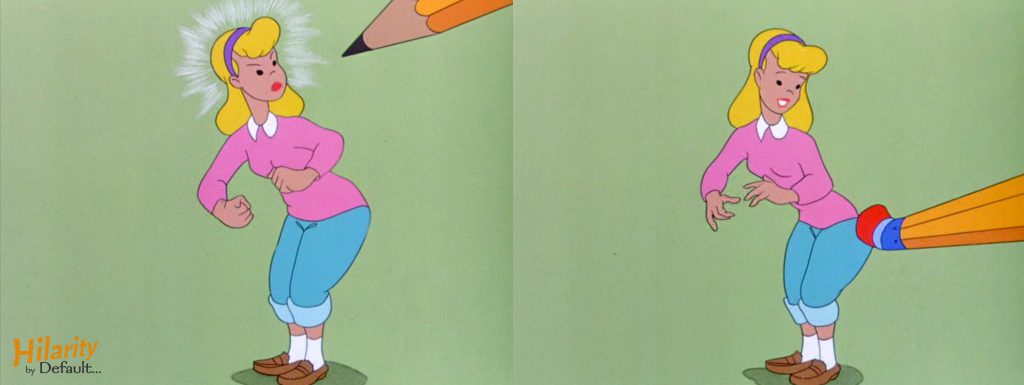
In an absurd twist, Disney did the exact same thing to one of the short’s characters for the DVD release. At the beginning of the segment, we follow a girl as she showers and prepares for her night out (which is punctuated by her spunky kid sister adorably mimicking her older sibling). In two blink-and-you’ll-miss-them shots, the sides of the girl’s breasts are momentarily visible as she hurries to towel up and get dressed. Alarmed at the thought of little boys armed with pause buttons, Disney proceeded to airbrush her boobs off.

It is confounding how hypocritically selective Disney can be when it comes to their own self-censorship. They go through all the trouble to airbrush the girl’s anatomy in this film but the far more revealing centaurettes from Fantasia are okay according to their puzzling standards?
 Is it because Fantasia is a much more lauded film or is the nudity of mythical beings a factor that makes it more acceptable? My guess would be that it was censored because of the younger age of the girl in question. Either way, both of the scenes have an innocent, rather than salacious, quality to them marking the effort as wholly unnecessary. It makes me wonder what Disney might decide to “purify” next…
Is it because Fantasia is a much more lauded film or is the nudity of mythical beings a factor that makes it more acceptable? My guess would be that it was censored because of the younger age of the girl in question. Either way, both of the scenes have an innocent, rather than salacious, quality to them marking the effort as wholly unnecessary. It makes me wonder what Disney might decide to “purify” next…
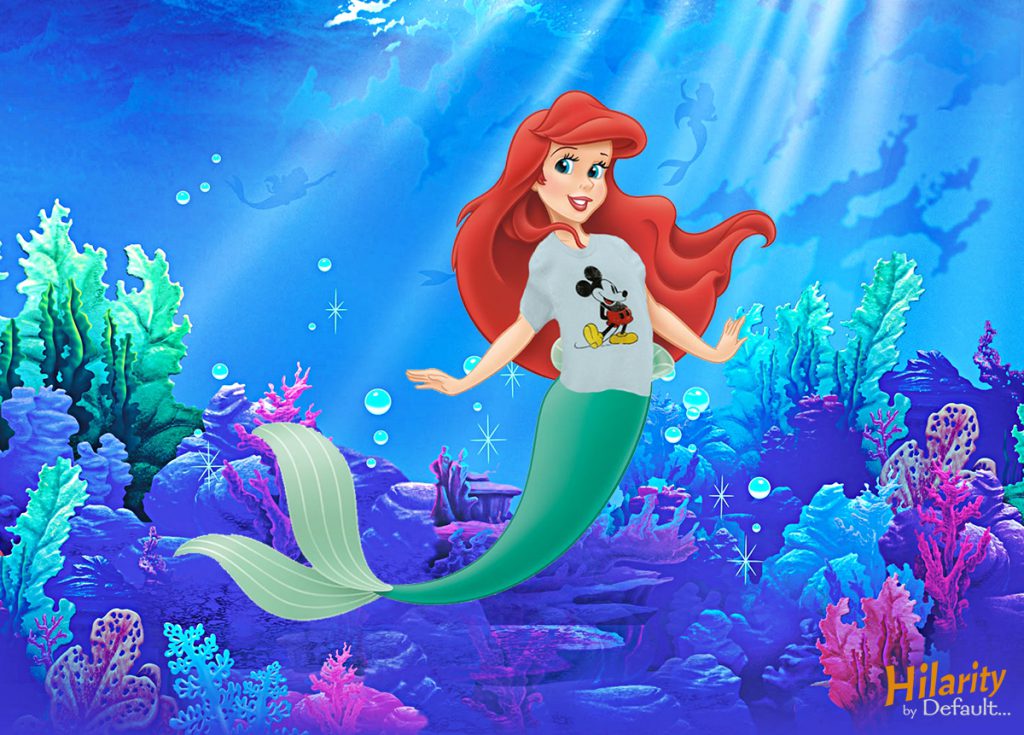
On the bright side, as opposed to the complete omission of “The Martins and the Coys,” the damage done here is practically insignificant (which makes it all the more questionable). “All the Cats Join In” remains a dynamic joy and one of the true gems of Make Mine Music.
Without You
|
3.0
|
Following the energetic “All the Cats Join In,” “Without You” ostensibly drops us right back into the languorous territory of “Blue Bayou.”
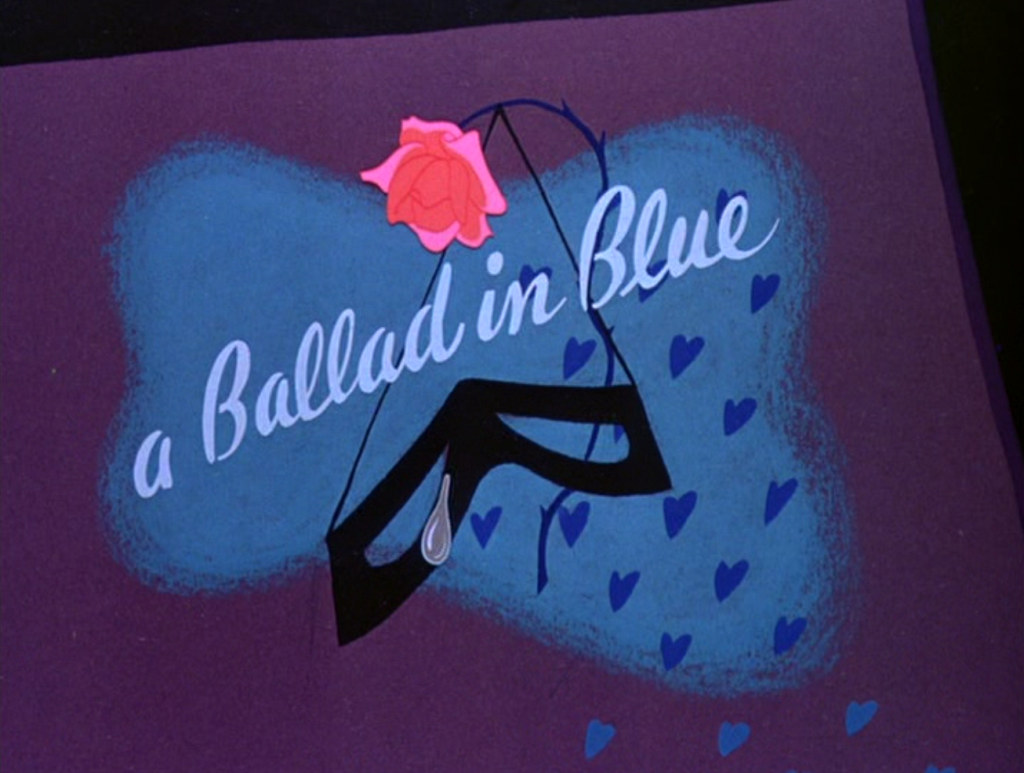
Centered around a ballad sung by Andy Russell, “Without You’s” theme is of lost love visualized through the falling drops of rain on a lonely house window. These drops transform into several impressionist illustrations in congruence with the song’s poignant lyrics.
Often derided as one of the weakest segments of Make Mine Music, I was surprised to find how much I actually enjoyed it. Unlike the similarly themed “Blue Bayou,” here the song flows with the visuals harmoniously, imbuing a dynamic that was sorely lacking in “Bayou.” Sure, the song is definitively a crooner but it does have a soothing, hypnotic rhythm to it, resembling a cross between “You Belong to My Heart” from The Three Caballeros and Matt Monro’s “From Russia with Love” from the 1963 James Bond film.
Although the animation falls short of the quality in “Bayou,” it still represents one of the most impressive efforts in the film reminiscent of an impressionist version of the abstract “Toccata and Fugue” from Fantasia but with the narrative flow of “Ave Maria.”
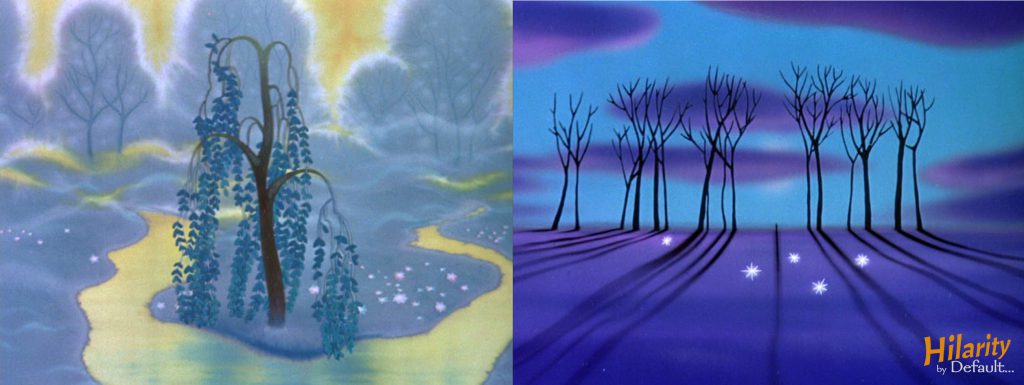 At a little under four minutes, “Without You” is the one of the shortest sequences in the film and it’s all the better for it. Any longer and it would have succumbed to its own melancholy. Is it one of the best segments in the film? Far from it, but it is a well-paced, visually arresting piece that may not deserve much of the derision it has sadly received.
At a little under four minutes, “Without You” is the one of the shortest sequences in the film and it’s all the better for it. Any longer and it would have succumbed to its own melancholy. Is it one of the best segments in the film? Far from it, but it is a well-paced, visually arresting piece that may not deserve much of the derision it has sadly received.
Casey at the Bat
|
3.0
|
Inspired by the infamous poem by Ernest Thayer, “Casey at the Bat” is about a mighty baseball player, loved by all (“but mostly the ladies”), whose hubris gets the best of him.
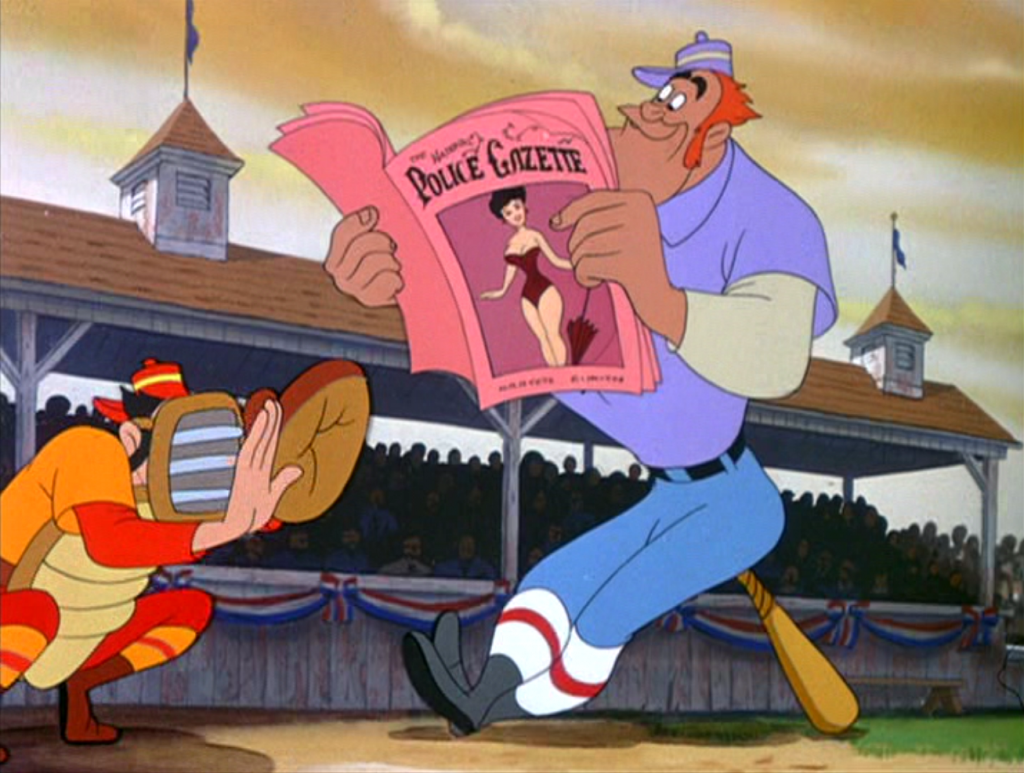
Narrated by Jerry Colonna (who would go on to voice the March Hare in Alice in Wonderland five years later), “Casey” is a slapstick exertion with a better focus and payoff than Make Mine Music‘s other farcical short, “The Martins and the Coys.”
Despite being a bit bogged down by some of the liberties taken with Thayer’s poem during its first half, a few of the new additions are quite clever in their own right. Casey’s obsession with ladies (and vice versa) is one such example, leading to some amusing, though unusually suggestive for Disney, lyrics:
He’s batting a thousand percent with the ladies
Casey has nerve and he knows every curve (cue wolf whistle)
He’s no hokey pokey
He gets away with that old double play (cue girls giggling)
He’s sure okey dokey
He makes all the ladies go gaga, it’s true
No wonder they swoon when he comes into view

Although the short suffers from some of the weakest animation in the film, Casey himself is a fun creation and his late appearance in the segment complements his build up beforehand well. Casey hits just the right balance between arrogance and likability – so much so that when he strikes out and loses the game at the end, it’s a funny, as opposed to depressing, moment.
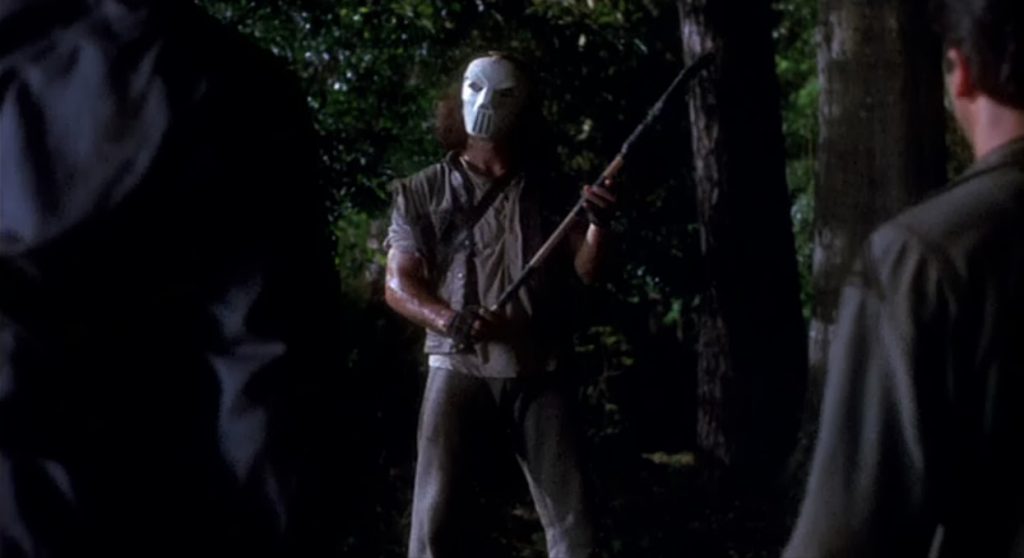
While “Casey” may not be the highlight of Make Mine Music, it’s far and away the film’s funniest segment. It’s not surprising that Disney decided to revisit the short eight years later with the release of an original sequel, “Casey Bats Again.”
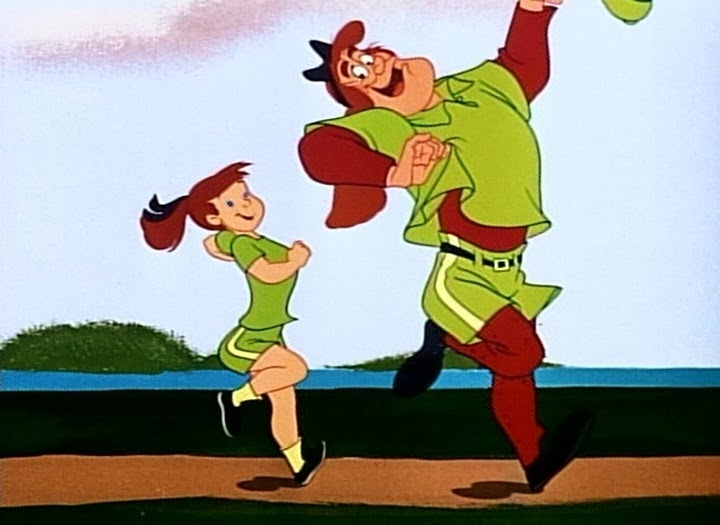
Two Silhouettes
|
2.5
|
As if to make retribution for spoofing ballet with elephants and hippos in Fantasia‘s “Dance of Hours,” “Two Silhouettes” is much more reverent, featuring two live-action dancers (Tania Riabouchinska and David Lichine) rotoscoped into a magical environment.
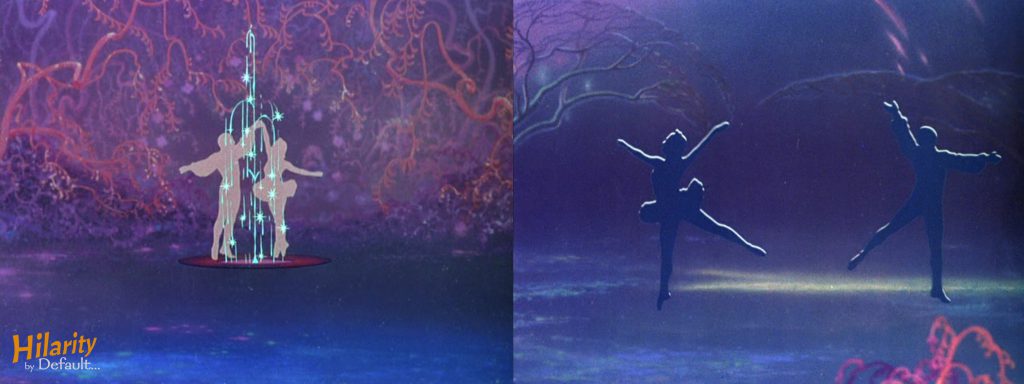 Like “Without You,” “Two Silhouettes'” lovely title song, sung by Dinah Shore, is also evocative of “You Belong to My Heart” from The Three Caballeros. In fact, both songs are so incredibly similar that there were times during “Two Silhouettes” where I could swear I was hearing the refrains “My Heart.” With the comparable surreal nature both songs afford in their respective films, I was half expecting a love struck Donald Duck to pop out of a nearby flower and start flirting with the ballerina.
Like “Without You,” “Two Silhouettes'” lovely title song, sung by Dinah Shore, is also evocative of “You Belong to My Heart” from The Three Caballeros. In fact, both songs are so incredibly similar that there were times during “Two Silhouettes” where I could swear I was hearing the refrains “My Heart.” With the comparable surreal nature both songs afford in their respective films, I was half expecting a love struck Donald Duck to pop out of a nearby flower and start flirting with the ballerina.
Thankfully, this effort is more subdued than its apparent cousin. In fact, the argument can be made that it is too subdued. While the animation is on par with “Without You” – especially the work done with the silhouetted dancers which is relatively striking – the sequence falls prey to sluggishness despite its short, 4 minute run-time.
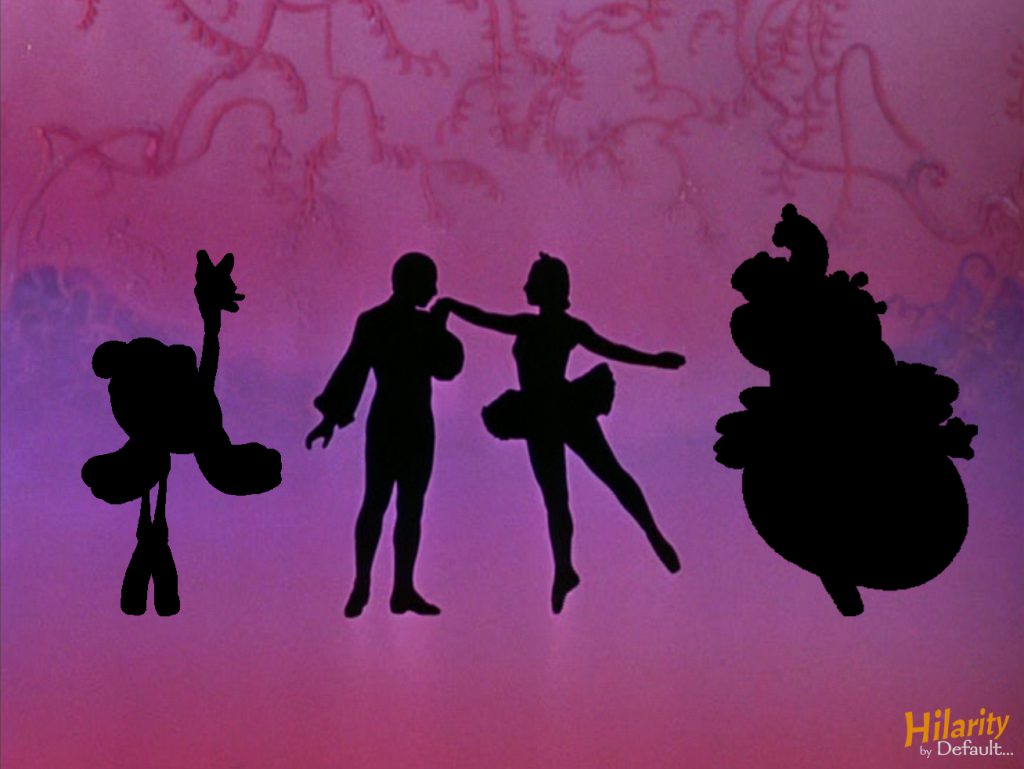
Peter and the Wolf
|
3.5
|
Probably the most famous section of Make Mine Music, “Peter and the Wolf” was originally considered to be included as part of a reissue of Fantasia. This idea was scrapped when the film under-performed at the box-office but was resurrected when production on Make Mine Music began.
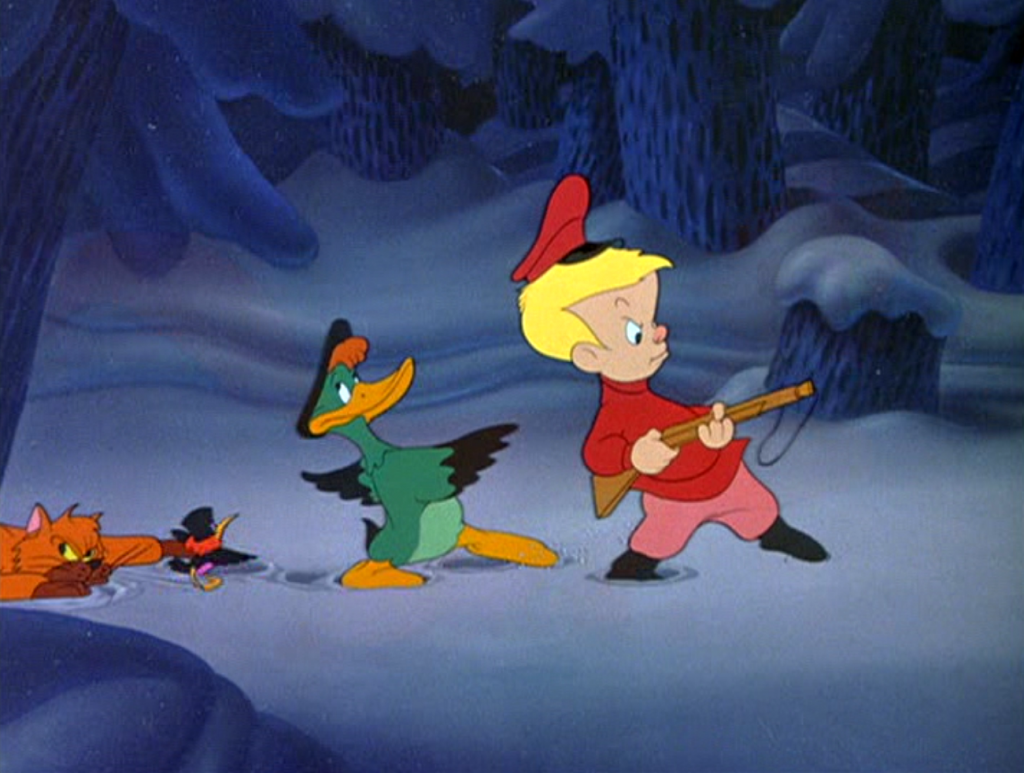 Based on the composition and story by Sergei Prokofiev, our “fairy tale with music” follows Peter, a daring young boy who, against his grandfather’s wishes, embarks on a wolf hunt. Accompanied by a cowardly duck, a conniving cat, and a feisty little bird, he soon comes face to face with this animated terror:
Based on the composition and story by Sergei Prokofiev, our “fairy tale with music” follows Peter, a daring young boy who, against his grandfather’s wishes, embarks on a wolf hunt. Accompanied by a cowardly duck, a conniving cat, and a feisty little bird, he soon comes face to face with this animated terror:
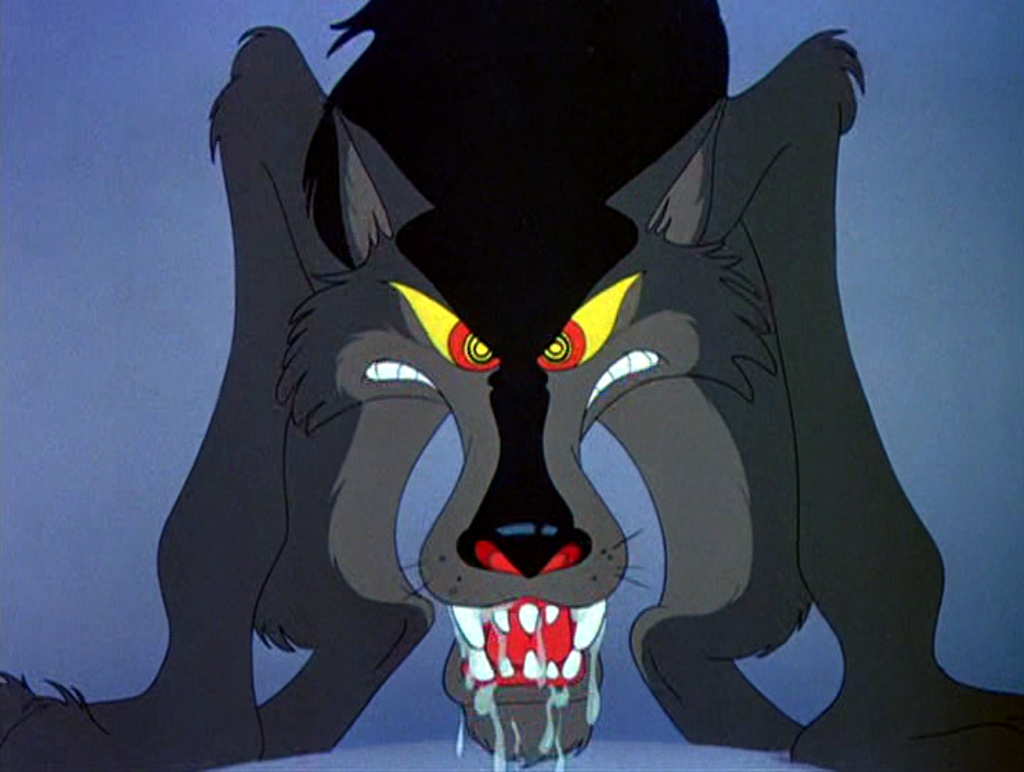
Chaos ensues but Peter eventually overtakes the wolf with the help of his animal friends and is paraded back into town as a local hero as a result. Disney’s adaptation is pretty faithful to Prokofiev’s original story with the biggest difference being the eventual fate of the duck. In Prokofiev’s version, the duck meets an untimely demise when eaten by the wolf. While the Disney cartoon does allude to this original casualty, it concludes on a happy note when it is discovered that the duck was able to escape the wolf’s clutches after all. This change may cheapen the story somewhat but given the lighthearted mood of the piece, it is an acceptable variation (and considering another major fatality later in the film, this change may have kept the film’s overall tone from being too depressing).
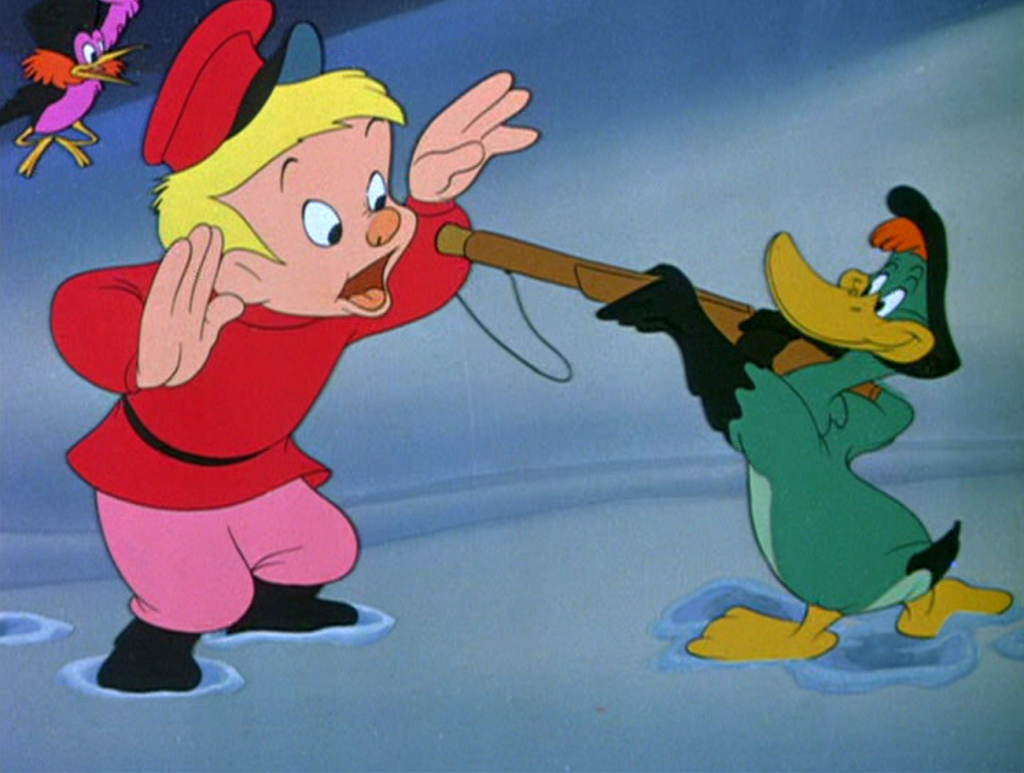
Narrated by the always delightful Sterling Holloway, “Peter and the Wolf” is one of the strongest segments in Make Mine Music. Preserving the original story’s tradition of assigning every character their own distinct instrumental representation, the score is an absolute pleasure – which isn’t shocking seeing that it was composed by Prokofiev himself. Wisely, the short does not fully rely on this concept; instead, it further develops the characters, providing them with quirky and endearing traits – particularly the bird and the duck.
And speaking of the bird, I couldn’t help but notice that the character seemed familiar somehow…
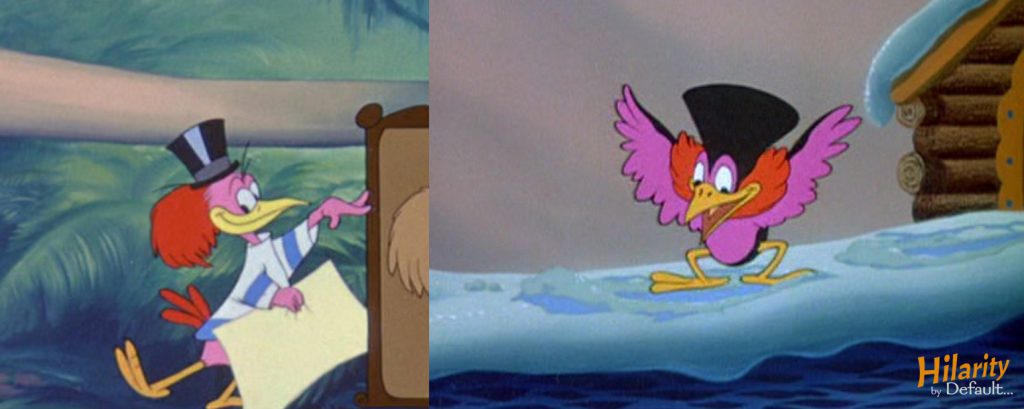
After You’ve Gone
|
3.5
|
Marking Ben Goodman’s second contribution to Make Mine Music (after the exuberant “All the Cats Join In”), “After You’ve Gone” is a surreal, energetic creation contrary to the despondency its title may suggest. There’s very little in terms of story as the piece follows a group of anthropomorphic instruments whose worlds and actions shift and change in accordance with the unpredictability of the jazzy instrumental.
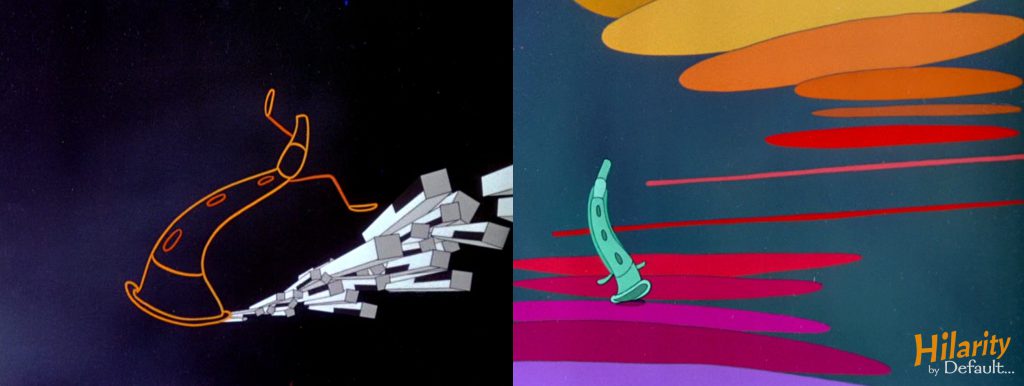 At almost exactly 3 minutes long, “After You’ve Gone” is Make Mine Music‘s shortest segment. With its frenetic pace and inventive energy, it feels half as long and may be the only section in the film that leaves its viewers wanting more. Ben Goodman’s orchestration is the true jazz highlight of the Music, eclipsing his work in “All the Cats Join In.”
At almost exactly 3 minutes long, “After You’ve Gone” is Make Mine Music‘s shortest segment. With its frenetic pace and inventive energy, it feels half as long and may be the only section in the film that leaves its viewers wanting more. Ben Goodman’s orchestration is the true jazz highlight of the Music, eclipsing his work in “All the Cats Join In.”
While the animation leaves a bit to be desired in comparison to some of the stronger work present in the film, the short is still full of creative ideas and visuals such as one scene where a piano player’s hands turn into a pair of dancing legs or another that features a boxing match during a bass solo.
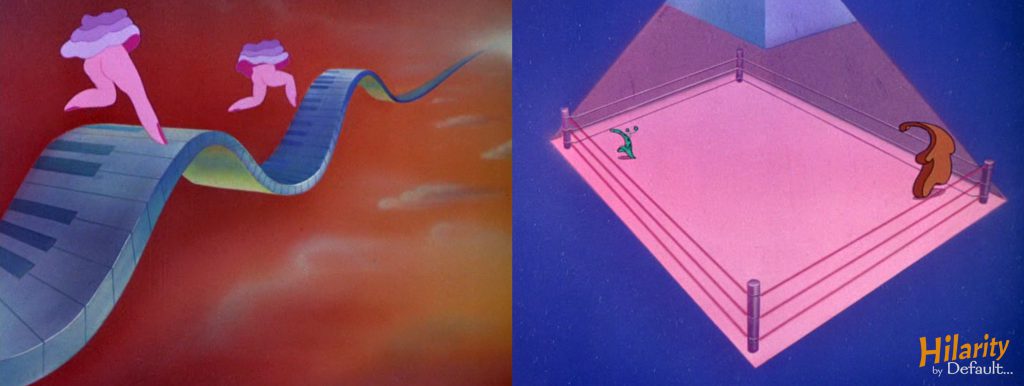
Johnnie Fedora and Alice Bluebonnet
|
2.5
|
After enduring egrets haunted by belated passion in “Blue Bayou” and a crestfallen croon about lost love in ‘Without You,” one would expect Make Mine Music would feature a more jubilant love story for counterbalance. Instead, we are thrust into the despairing tale of Johnnie Fedora. After having met and lost Alice, the true love of his life, he embarks on a journey to find her as poverty and heartache threaten to overtake him. After being beat up, shot at, trampled, bitten by stray dogs, frozen, crushed, and maimed, they finally reunite for a much-deserved happy ending.
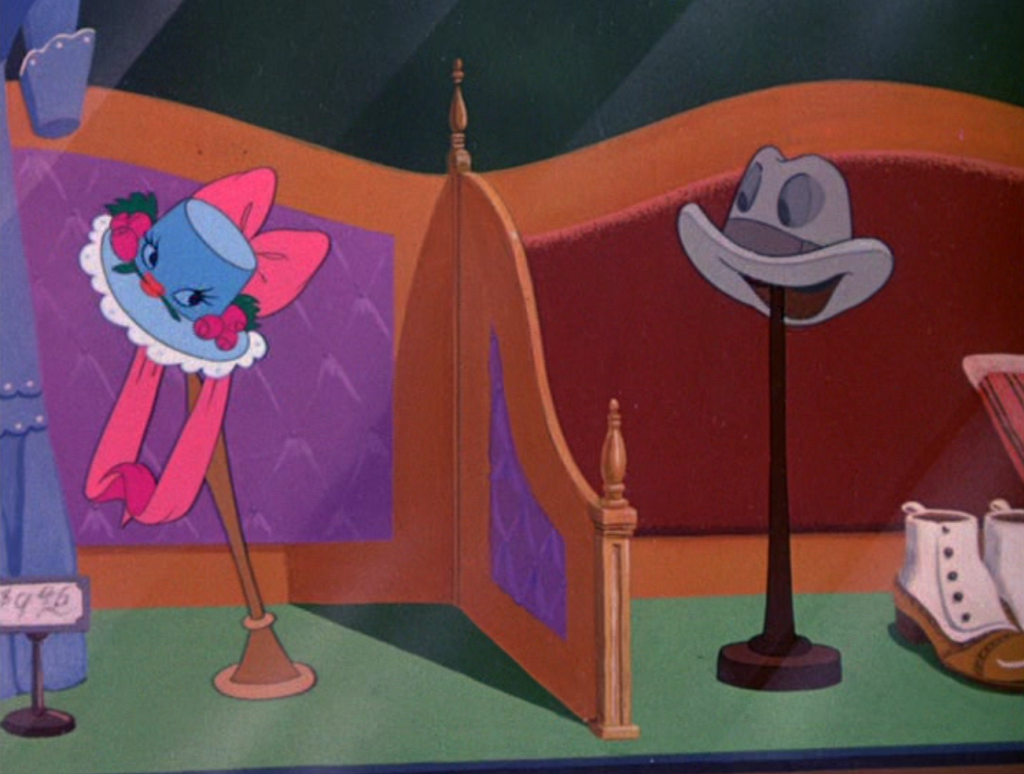
As silly as it sounds, it is startling how effective “Johnnie Fedora and Alice Bluebonnet” is. The story is strong and the song sung by the Andrews Sisters is compelling (even if it shares “It’s a Small World’s” sickly sweet trait of gnawing on one’s head). Though the narrative may be downright depressing at times, “Johnnie” is not lacking of several inspired moments of witty fun such as Johnnie and Alice’s dream hatbox house (complete with baby bonnets) or, my personal favorite, a desperate chance encounter between them in a crowded street thwarted by a caustic billboard on wheels:
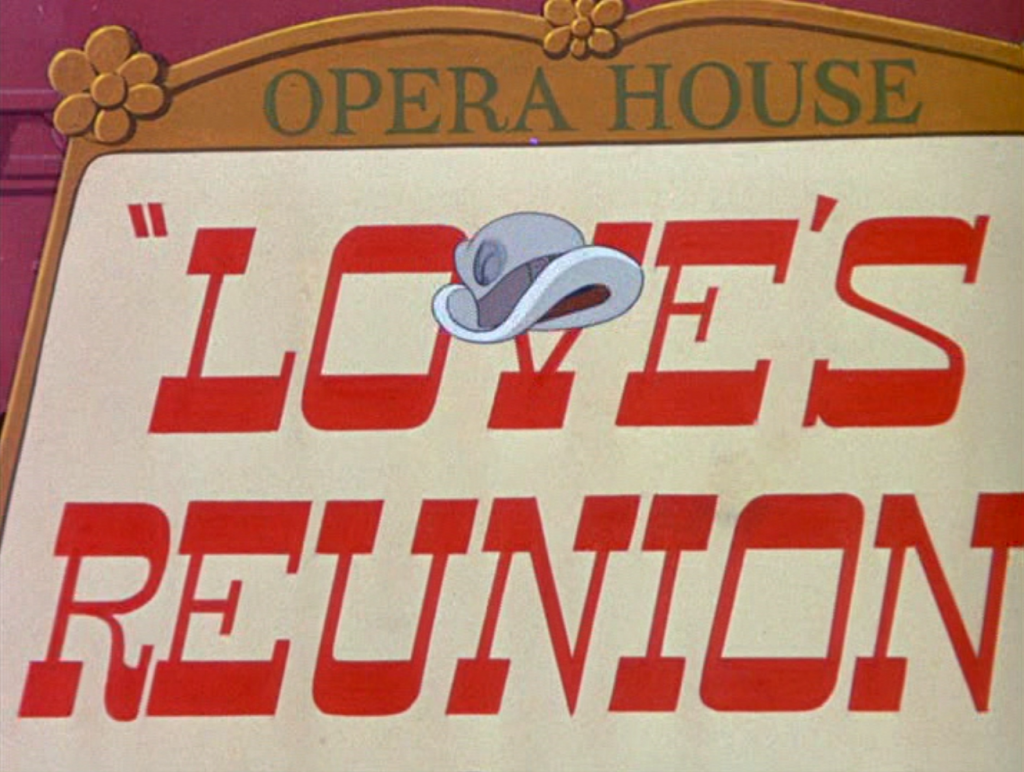
The short’s biggest detriment is its sub-par animation, indicative of the lowest quality in all of Make Mine Music save for Johnnie himself. It is a testament of exceptional character work when the simple design of Johnnie elicits so much emotion. The rest of the characters and animation (especially the freeze frame stills of practically everything else) may be passé, but Johnnie holds the piece together flawlessly, giving strength to “Johnnie Fedora’s” most vital element.
Admittedly, the short does fall prey to over-sentimentality at times but its positive, happy ending does provide a cute twist in a manner that it playfully unexpected. Disney would revisit a similar, struggling anthropomorphic object formula again in several short cartoons, such as 1952’s “Susie the Little Blue Coupe” (which practically hits all the same story beats as “Johnnie Fedora”).
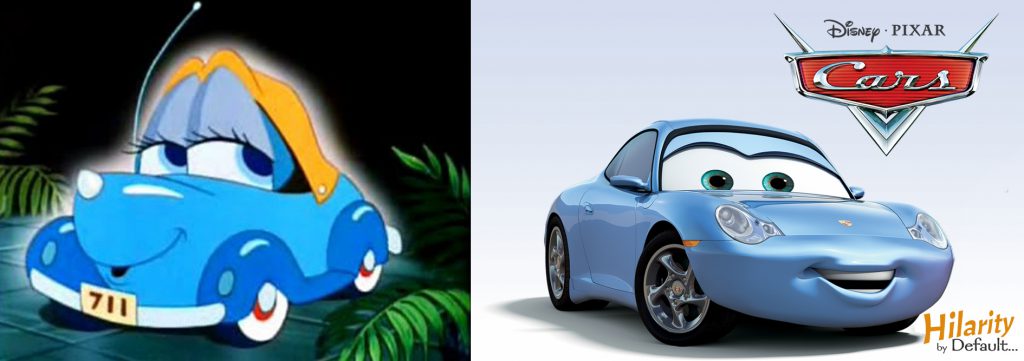
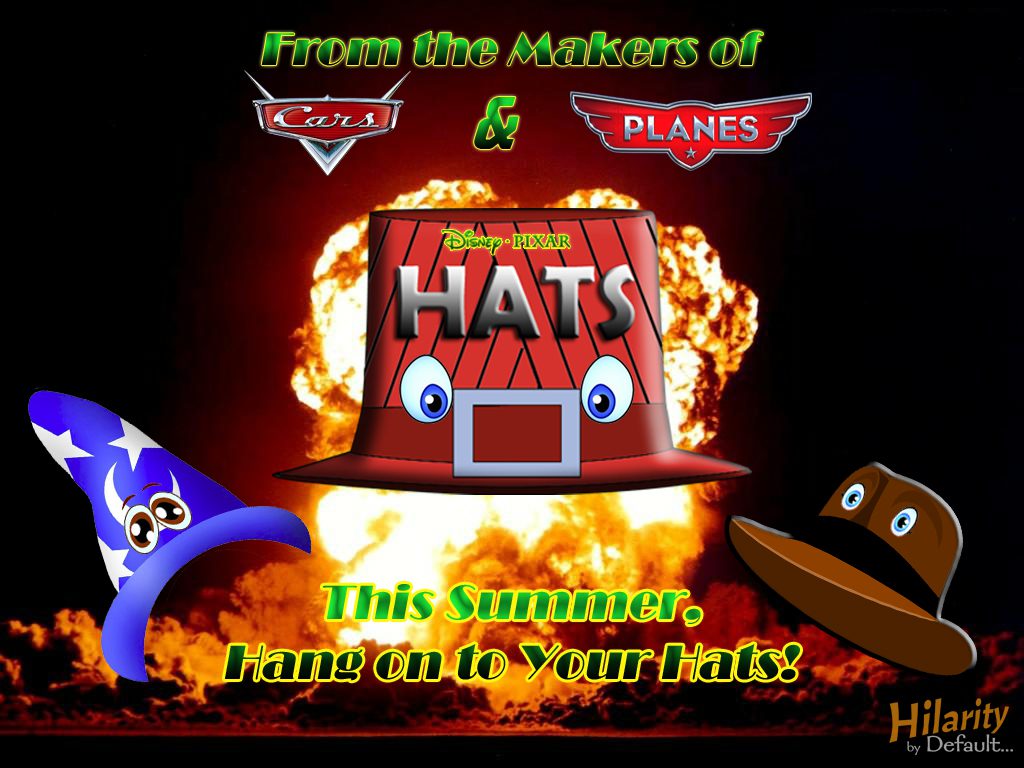
The Whale Who Wanted to Sing at the Met
|
4.0
|
Finally, we come to Make Mine Music‘s denouement, “The Whale Who Wanted to Sing at the Met,” also known as “Willie the Operatic Whale.” It is by far Music‘s best, longest, and most audacious set piece, featuring a virtuosic performance by Nelson Eddy who provides all the voices in the short – be it male or female; tenor or bass; whale or kitty-cat.
The story revolves around Willie, a miraculous opera-singing whale who garners the attention of famed impresario Tetti-Tatti who foolishly believes that the whale’s talents are really from an opera singer swallowed whole by the beast, akin to the Biblical tale of Jonah.
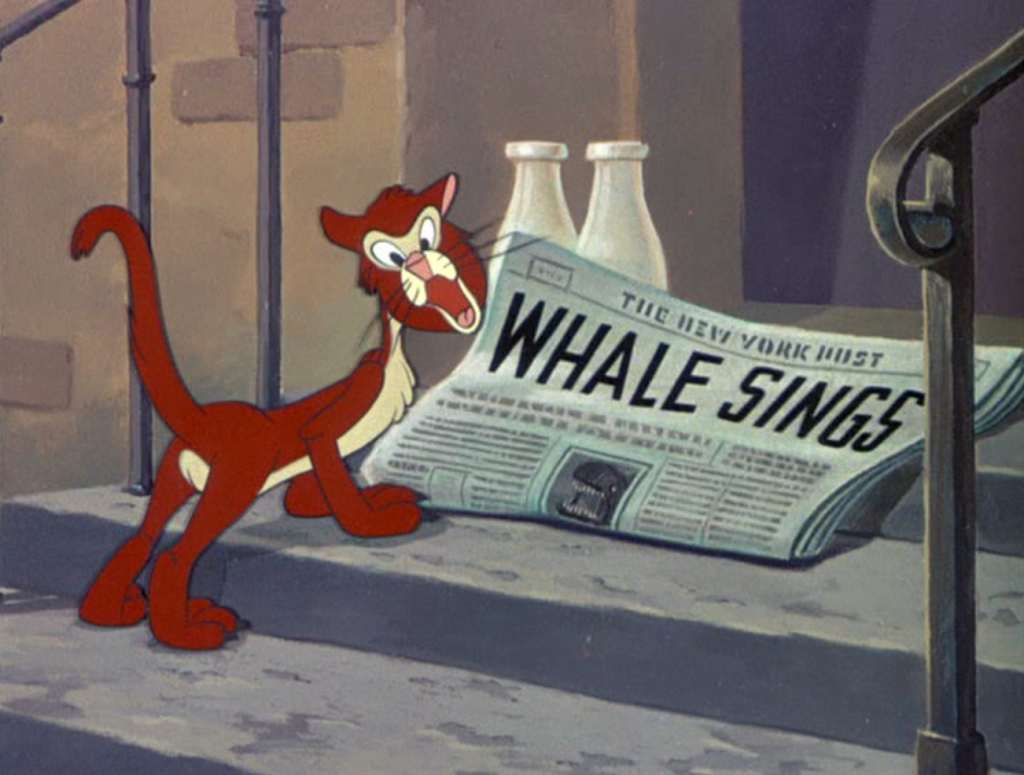
Setting sail in a whaling ship, Tatti embarks on a journey to find the symphonic cetacean and rescue the doomed opera singer. With the help of Willie’s seagull groupie, who is under the impression that he is scouting for talent, Tatti finds the serenading Willie and hastefully prepares his harpoon gun. Naturally, in true Disney fashion, he realizes his error in the nick of time and Willie is launched on a world tour gaining fame and fortune through his various performances.

Nah, just kidding. Instead, Tetti-Tatti harpoons the poor whale to death right then and there, leaving Willie’s seagull friend sobbing alone in the aftermath.

Although it is punctuated by a bittersweet epilogue with Willie’s spirit singing in heaven, it still is quite a gloomy ending, not only for the short but for the film altogether. Remarkably, it works incredibly well. Willie is such an optimistic and charming character that his fate absolutely stings; nevertheless, it rings true to the overall story and it doesn’t charge any unmerited emotions.
“The Whale Who Wanted to Sing at the Met” is a daring move for Disney, taking a 180° turn on the sugar and cupcake aura that has often been attributed to the studio (particularly in the decades to follow). Although it may not be representative of my favorite section of Make Mine Music – that title still belong to “All the Cats Join In” – it is unequivocally the best.

Final Thoughts |
It’s not surprising that Make Mine Music is one of the least remembered films in the Disney animated canon, especially considering its status as one of the package films. It’s definitely the most tonally inconsistent, featuring jarring shifts in quality and mood. The cartoons that do stand out (such as “The Whale Who Wanted to Sing at the Met” and “Peter and the Wolf”) are often remembered as their own separate entities rather than part of this compilation (years of Disney reissuing them as their own individual home video releases has certainly added to this stigma). Moreover, without an identifiable, classic Disney character making an appearance analogous with the majority of the package features, it’s easy to see how the film has been overlooked (especially from a marketing perspective).
Thankfully, there are enough exceptional sequences that serve as independent examples of some of the bolder work accomplished by the studio in the mid-40’s such as the more mature tone of the Willie the Whale short, the technical achievement of “Two Silhouettes,” or the animated caricature sketches of “All the Cats Join In.”
All in all, Make Mine Music as a whole is a tolerable venture. If there is one word that best describes it, it would be “mediocre.” Come to think of it, Make Mine Mediocre does expel a certain ring of truth to it.
Man-Card Retribution |

Fantastic! It’s been nearly two months since my last Man-Card!

Can’t really blame you for that.
Man-Card Retribution: Status Quo
Random Afterthoughts… |
I have to admit that I was a bit distracted by the emaciated waist of department store clerk in “Johnnie Fedora and Alice Bluebonnet.” I had the sudden urge to run out and buy her a sandwich.
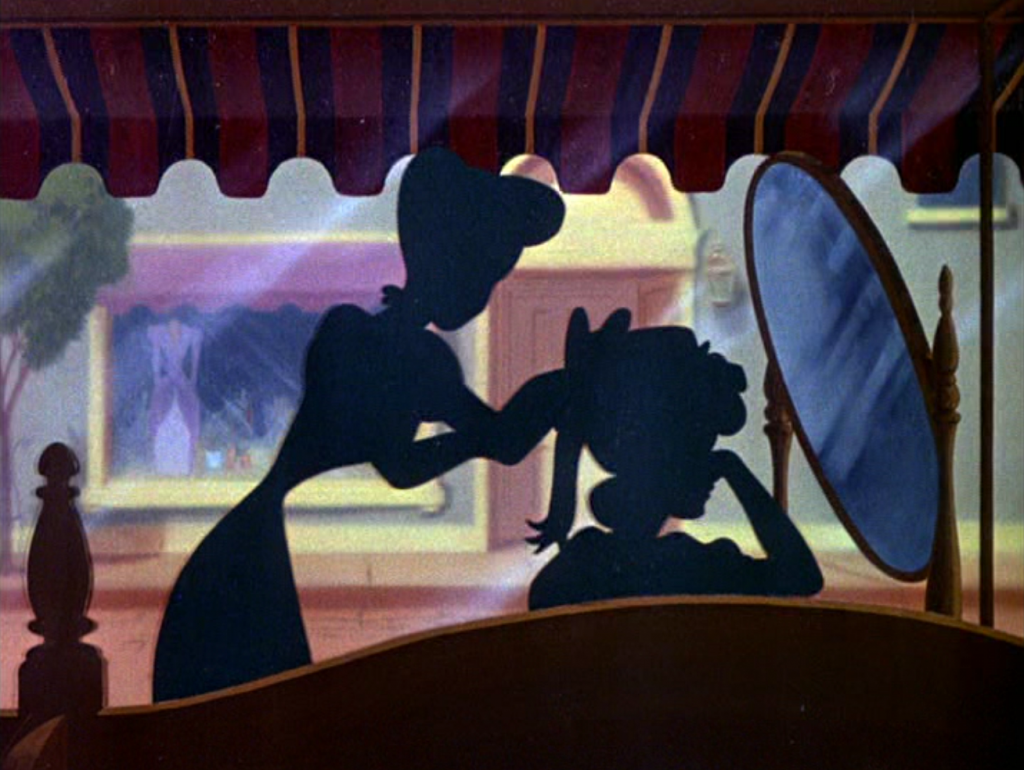
Wait a second! Did one of the demonic phantoms from Fantasia‘s “Night on Bald Mountain” escape and invade the world of Willie the Operatic Whale?
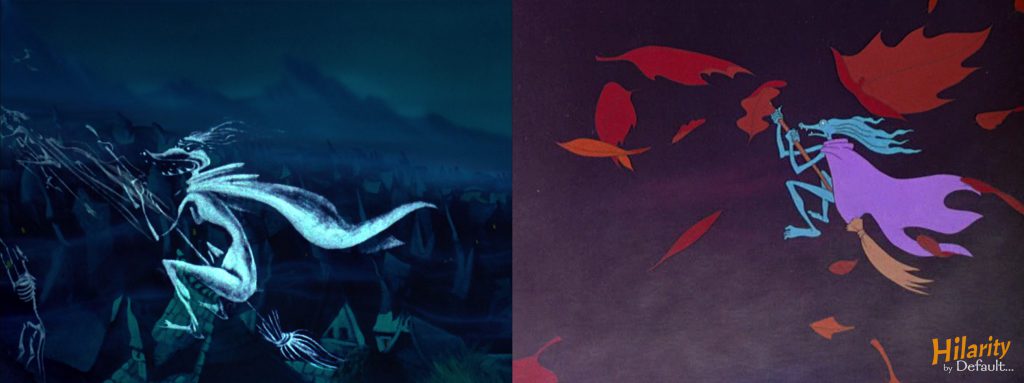
 Join us next time as we continue the tale of “Casey at the Bat” with “Casey Bats Again” (1954). For more Default Disney, click here.
Join us next time as we continue the tale of “Casey at the Bat” with “Casey Bats Again” (1954). For more Default Disney, click here.




















